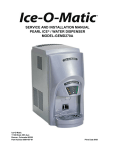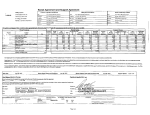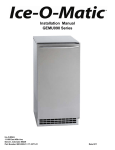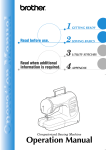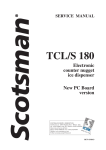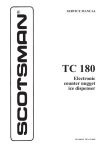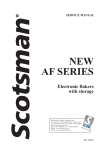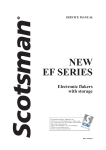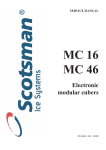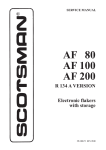Download MDT2C12
Transcript
MDT2 INTRODUCTION This manual provides the specifications and the step-by-step procedures for the installation, start-up, operation, maintenance and cleaning for the SCOTSMAN MDT2 counter top cubelet ice dispenser. NOTE: To retain the safety and performance built into this ice machine, it is important that installation and maintenance be conducted in the manner outlined in this manual. Table of Contents SPECIFICATIONS · · · · · · · · · · · · · · · · · · · · · · · · · · · · · · · · · · · · · · · · · · · · · Page 2 CABINET DIAGRAMS · · · · · · · · · · · · · · · · · · · · · · · · · · · · · · · · · · · · · · · · · · Page 3 GENERAL INFORMATION AND INSTALLATION · · · · · · · · · · · · · · · · · · · · · · · · · · · · Page 4 ELECTRICAL CONNECTIONS · · · · · · · · · · · · · · · · · · · · · · · · · · · · · · · · · · · · · · Page 5 WATER SUPPLY AND DRAIN CONNECTIONS · · · · · · · · · · · · · · · · · · · · · · · · · · · · · Page 6 FINAL CHECK LIST · · · · · · · · · · · · · · · · · · · · · · · · · · · · · · · · · · · · · · · · · · · · Page 7 OPERATING INSTRUCTIONS · · · · · · · · · · · · · · · · · · · · · · · · · · · · · · · · · · · · · · Page 8 INITIAL START UP CONTINUED · · · · · · · · · · · · · · · · · · · · · · · · · · · · · · · · · · · · · Page 9 SETTING THE DISPENSING SELECTOR · · · · · · · · · · · · · · · · · · · · · · · · · · · · · · · · Page 11 PRINCIPLE OF OPERATION · · · · · · · · · · · · · · · · · · · · · · · · · · · · · · · · · · · · · · · Page 12 REFRIGERANT CIRCUIT · · · · · · · · · · · · · · · · · · · · · · · · · · · · · · · · · · · · · · · · · Page 13 MECHANICAL SYSTEM · · · · · · · · · · · · · · · · · · · · · · · · · · · · · · · · · · · · · · · · · Page 14 COMPONENT DESCRIPTION · · · · · · · · · · · · · · · · · · · · · · · · · · · · · · · · · · · · · · Page 15 COMPONENT DESCRIPTION · · · · · · · · · · · · · · · · · · · · · · · · · · · · · · · · · · · · · · Page 16 COMPONENT DESCRIPTION · · · · · · · · · · · · · · · · · · · · · · · · · · · · · · · · · · · · · · Page 17 COMPONENT DESCRIPTION · · · · · · · · · · · · · · · · · · · · · · · · · · · · · · · · · · · · · · Page 18 SERVICE DIAGNOSIS · · · · · · · · · · · · · · · · · · · · · · · · · · · · · · · · · · · · · · · · · · Page 19 SERVICE DIAGNOSIS · · · · · · · · · · · · · · · · · · · · · · · · · · · · · · · · · · · · · · · · · · Page 20 MAINTENANCE AND CLEANING INSTRUCTION · · · · · · · · · · · · · · · · · · · · · · · · · · · · Page 21 CLEANING INSTRUCTIONS OF WATER SYSTEM · · · · · · · · · · · · · · · · · · · · · · · · · · · Page 22 REMOVAL AND REPLACEMENT · · · · · · · · · · · · · · · · · · · · · · · · · · · · · · · · · · · · Page 23 TOP BEARING REPLACEMENT · · · · · · · · · · · · · · · · · · · · · · · · · · · · · · · · · · · · · Page 24 BEARING REPLACEMENT - CONTINUED · · · · · · · · · · · · · · · · · · · · · · · · · · · · · · · · Page 25 WATER SEAL · · · · · · · · · · · · · · · · · · · · · · · · · · · · · · · · · · · · · · · · · · · · · · · Page 26 May 2002 Page 1 MDT2 SPECIFICATIONS MDT2C12: Ice Maker Dispenser TouchFree 200 lb ice making capacity Cublet 12 lb storage Important operating requirements: MIN MAX - Air temperature 50°F 100°F - Water temperature 40°F 95°F - Water pressure 20 psi 70 psi - Electrical voltage variations from voltage rating specified on nameplate -10% +10% To keep your SCOTSMAN CUBELET DISPENSER at peak performance levels, periodic maintenance checks must be carried out as indicated in this manual. MACHINE SPECIFICATIONS Model Cond. unit Air MDT2C12-1A Basic electrical 115/60/1 Cabinet Size Finish 34 13/32” high x 15 9/32” wide x 26 7/64” deep S. Steel Amps Watts Amps fuse 6 550 15 Unit is equipped with leveling legs. The unit has a power cord. May 2002 Page 2 Comp. HP 3/8 Ice bin cap 12 lb. MDT2 CABINET DIAGRAMS May 2002 Page 3 MDT2 GENERAL INFORMATION AND INSTALLATION UNPACKING AND INSPECTION LOCATION AND LEVELING 1. Call your authorized SCOTSMAN Distributor or Dealer for proper installation. 2. Visually inspect the exterior of the packing and skid. Any severe damage noted should be reported to the delivering carrier and a concealed damage claim form filled in subject to inspection of the contents with the carrier’s representative present. 3. a) Cut and remove the plastic strip securing the carton box to the skid. b) Cut open the top of the carton and remove the polystyrene protection sheet. c) Pull out the polystyrene posts from the corners and then remove the carton. 4. Remove the top and sides panels of the unit and inspect for any concealed damage. Notify carrier of your claim for the concealed damage as stated in step 2 above. 5. Remove all internal support packing and masking tape. 6. Check that refrigerant lines do not rub against or touch other lines or surfaces, and that the fan blades move freely. WARNING: This Ice Dispenser is designed for indoor installation only. If the machine is operated for extended periods at temperatures exceeding the following limitations it will constitute misuse under the terms of the SCOTSMAN Manufacturer’s Limited Warranty resulting in LOSS of warranty coverage. Position the unit in the selected permanent location. Criteria for selection of location include: Min Air Temperature 50°F Water Temperature 40°F Water pressure 20 psi Voltage -10% (Compared to the nameplate) Max 100°F 95°F 70 psi +10% Service access: adequate space must be left for all service connections through the rear of the ice machine. 7. Check that the compressor fits snugly onto all its mounting pads. This machine is air-cooled and sucks air through the left side panel and blows air out the rear side of the top panel. Do not install the machine where the left and upper rear side airflows might be blocked. 8. Use clean damp cloth to wipe the surfaces outside of the cabinet. A minimum clearance of 6 inches is required at the left and upper rear side for air circulation. 9. See data plate on the rear side of the unit and check that local main voltage corresponds with the voltage specified on it. It is important that the machine be installed in a location where it has enough space around it to be accessible for service. Avoid hot, dirty and crowded locations. CAUTION: Incorrect voltage supplied to the ice machine will void your parts replacement program. NOTE: Do NOT place anything on top of the machine. Leave the upper louvers open for proper air exhaust. 10. Remove the manufacturer’s registration card from the inside of the Users Manual and fill-in all parts including Model and Serial Number taken from the data plate. Forward the completed self-addressed registration card to SCOTSMAN factory. The base of the MDT2 must be sealed to the counter top. 1. Place the unit in its final position. 2. Place a bead of sealant on the counter top to match the outside edge of the cabinet base and sink. Food grade silastic sealant such as Scotsman part number 19-0529-01 is recommended. May 2002 Page 4 MDT2 ELECTRICAL CONNECTIONS See data plate for current requirements to determine wire size to be used for electrical connections. All SCOTSMAN ice machines require a solid earth wire. This SCOTSMAN ice machine is supplied from the factory completely pre-wired and only needs to be plugged into a nearby 115 volt outlet. Make sure that the ice machine is connected to its own circuit and individually fused (see data plate for fuse size). The maximum allowable voltage variation should not exceed -10% and +10% of the data plate rating. Low voltage can cause faulty functioning and may be responsible for serious damage to the overload switch and motor windings. NOTE: All external wiring should conform to national, state and local standards and regulations. Check voltage on the line and the ice machine’s data plate before connecting the unit. May 2002 Page 5 MDT2 WATER SUPPLY AND DRAIN CONNECTIONS GENERAL WATER DRAIN When choosing the water supply for the ice flaker, consideration should be given to: The recommended drain tube is a copper, rigid plastic or reinforced flexible tubing (supplied) with .75" (19mm) I.D. which runs to an open trapped and vented drain. When the drain is a long run, allow1/4" drop per foot. a) Length of run b) Water clarity and purity c) Adequate water supply pressure Note: Although soft, easily kinked vinyl tubing is not recommended for a drain, a short length of ¾” ID vinyl tubing is required to connect a rigid drain tube to the 20 mm (25/32”) fitting on the back of the MDT2. Water is the most important single ingredient in producing ice - these three items are very important. Low water pressure, below 20 psi may cause malfunction of the ice machine unit. Water containing excessive minerals will tend to produce scale build-up on the interior parts of the water system while water that’s too soft (water contains too few mineral salts), will produce a very hard flaked ice. PLUMBING CONNECTIONS MUST CONFORM TO ALL APPLICABLE CODES CONNECT TO POTABLE WATER ONLY The model MDT2 is capable of having water connections through the bottom base or through the rear bottom side of the machine. In this second case it is necessary to remove the small panel at the bottom rear. Install a vertical open vent on the drain line high point at the drain connection to ensure good draining. The ideal drain receptacle is a trapped and vented floor drain. NOTE: The water supply and the water drain must be installed to conform with the local code. In some case a licensed plumber and/or a plumbing permit is required. WATER SUPPLY Connect to the 3/4" male water inlet fitting, using the supplied fitting, to the cold water supply line. A shut-off valve should be installed in an accessible position between the water supply line and the unit. If the water contains a high level of impurities, consider installing a water filter or conditioner. May 2002 Page 6 MDT2 FINAL CHECK LIST 1. Is the unit in a room where the ambient temperatures are within a minimum of 50°F even in winter months? 2. Is there at least a 6" clearance around the unit for proper air circulation? 3. Is the unit level? 4. Have all the electrical and plumbing connections been made, and is the water supply shut-off valve open? 5. Has the voltage been tested and checked against the data plate rating? 6. Has the water supply pressure been checked to ensure a flowing water pressure of at least 20 psi. 7. Check all refrigerant lines and conduit lines to guard against vibrations and possible failure. 8. Has the unit been sealed to the counter top? 9. Has the owner/user been given the Users Manual and been instructed on the importance of periodic maintenance checks? 10. Has the Manufacturer’s registration card been filled in properly? Check the model and serial number against the serial plate and mail the registration card to Scotsman. 11. Has the owner been given the name and the phone number of the authorized SCOTSMAN Service Agency serving them? May 2002 Page 7 MDT2 OPERATING INSTRUCTIONS INITIAL START UP After having correctly installed the ice machine and completed the plumbing and electrical connections, perform the following “Start-up” procedure. B. After 3 minutes have elapsed – the stand by period – the unit starts operating by activating systems in following sequence: 1. GEAR MOTOR 2. COMPRESSOR Remove the control board inspection panel and cover to view the lights on the control board. 3. FAN MOTOR – which is controlled by the condenser temperature sensor. The probe is within the condenser fins. A. Open the water supply line shutoff valve and turn the main switch on the power supply line to the ON position. 4. 2nd RED LED switches off (Fig. 2). C. Two or three minutes after compressor start up; cubelet ice should begin dropping off the ice spout into the storage bin. The GREEN LED will glow to signal that unit is under power. NOTE: Every time the unit is turned on after being shut off for a period of time (electrically disconnected) the 2nd RED LED will blink for 3 minutes (Fig.1). Reset button Fig 1 BLINKING – 3 MIN. STAND-BY PERIOD Bin empty Bin full Hi cond temp when Steady 3 minute wait when Blinking No water Auger Motor when Steady Hi evap temp when Blinking Power Reset button Fig 2 Bin empty Bin full Hi cond temp when Steady 3 minute wait when Blinking No water Auger Motor when Steady Hi evap temp when Blinking Power May 2003 Page 8 MDT2 INITIAL START UP CONTINUED NOTE: If the evaporating temperature has not dropped lower than 30° F within ten minutes of compressor start-up, the evaporating temperature sensor will detect the abnormal temperature and stop the unit operation. In this circumstance, the 3rd warning YELLOW LED will blink (Fig.3). After diagnosing and eliminating the cause of the poor evaporating temperature (insufficient refrigerant in the system, inoperative compressor or inoperative evaporator sensor), push the RESET BUTTON on the control board. Before resuming operation the unit will go through the usual 3 minute STAND-BY period. OPERATION CHECKS UPON THE UNIT START UP D. Remove the service panels and (if needed) connect the refrigerant service gauges to the corresponding service valves to check both the HI and LO refrigerant pressures. NOTE:The condenser temperature sensor, which is located within the condenser fins, keeps the head (condensing) pressure between two preset valves. If proper flow of cooling are is prevented by a clogged condenser or inoperative fan motor, the condenser temperature rises. When it reaches 158° F the condenser temperature sensor shuts-off the ice machine and turns on the 2nd RED WARNING LIGHT (Fig.4). Reset button Fig 3 Bin empty Bin full Hi cond temp when Steady 3 minute wait when Blinking No water Auger Motor when Steady Hi evap temp when Blinking Power Reset button Fig 4 Bin empty Bin full Hi cond temp when Steady 3 minute wait when Blinking No water Auger Motor when Steady Hi evap temp when Blinking Power May 2003 Page 9 MDT2 signaling that there is a full storage bin (Fig.6). After diagnosing and fixing the cause of the temperature rise, push the RESET BUTTON on the control board. Before resuming operation the unit will go through the usual 3 minute STAND-BY period. E. Check for the correct CUT-OUT and CUT-IN of the float reservoir water level sensors by shutting off the valve on the water supply line. This will cause a gradual decrease of the water level in the float reservoir and as soon as the level gets below the sensors, the flaker stops operating and the 5th YELLOW WARNING LED will glow to signal the shortage of water (Fig.5). NOTE: The water level sensor detects the presence of sufficient water in the float reservoir and confirms it to the microprocessor by maintaining a low voltage current flow between the two sensors using the water as conductor. CAUTION: The use of de-mineralized water (water with no salt content) having an electrical conductivity lower than 30mS, will cause the water sensors to stop working properly which will CUT-OUT the flaker operations and turn on the YELLOW LED that indicates a shortage of water, even though water is indeed in the reservoir. After this is done, open the water supply line shutoff valve to refill the float reservoir; the 5th YELLOW LED goes off and the 2nd RED LED starts blinking. The gear motor will start-up immediately, 2 seconds later the compressor will start and after the 3 minutes the unit resumes normal operation. F. To check for the correct operation of the electronic eye that controls ice bin level, place one hand between the sensing “eye” (located in the ice spout) to interrupt the light beam. This interruption will cause the 1st RED LED to go out. After about 6 seconds the unit shuts off and the 6th YELLOW LED will light Remove your hand to allow the electronic eye to resume normal operation. After about 6 seconds the flaker will resume the ice making process and the YELLOW LED will turn off – after the 3 minute STAND-BY period. NOTE: The ICE LEVEL CONTROL (INFRARED SYSTEM) is independent of the temperature. However, the reliability of its detection can be affected by dirt and scale sediment that may deposit directly on the light source and on the receiver. To prevent ice machine malfunction due to sediment build-up, be sure to follow the instructions for the periodic cleaning of the light sensor elements as detailed in the MAINTENANCE AND CLEANING INSTRUCTIONS section of this manual. Reset button Fig 5 Bin empty Hi cond temp when Steady 3 minute wait when Blinking Auger Motor when Steady Hi evap temp when Blinking Bin full No water Power Reset button Fig 6 Bin empty Hi cond temp when Steady 3 minute wait when Blinking Auger Motor when Steady Hi evap temp when Blinking May 2003 Page 10 Bin full No water Power MDT2 SETTING THE DISPENSING SELECTOR Setting the dispensing time It’s possible to modify the dispensing time to 5, 10 or 15 seconds. To modify the original setting time (5 seconds): a) Push and hold the 4th switch (CONTINUOUS) for 10 seconds until the first 3 lights start to blink, b) Push & release the 1st switch (ICE) for a 5 second dispense. a) First, select the Dispensing Mode by pushing the proper switch. b) Place a glass or a carafe in front of the two Optical Dispensing Devices. c) The dispensing drive motor and/or the water solenoid valve starts. Ice and/or water is discharged through the bottom plastic spout. The drive motor and/or the water solenoid valve remains in operation (per dispensing time settings) unless the glass or carafe is removed. nd c) Push & release the 2 switch (ICE AND WATER) for a 10 second dispense. d) Push & release the 3rd switch (WATER) for a 15 second dispense. The unit resumes a default dispense setting (Ice, Ice and Water or Water) after each dispense. To modify the resume mode (from factory set to ICE) push the desired switch (ICE, ICE AND WATER or WATER ) for 5 seconds. Push the CONTINUOUS switch and check again for the dispensing mechanism operation per the steps above. The drive motor and/or the water solenoid valve will remain in operation until the glass or carafe is removed. I. If connected, remove the refrigerant service gauges and re-attach the service panels. H. CHECK OF THE DISPENSING OPERATING MECHANISM To check for the correct operation of the dispensing mechanism: J. Instruct the owner/user on the general operation of the ice machine and its required cleaning and care. May 2002 Page 11 MDT2 PRINCIPLE OF OPERATION WATER CIRCUIT The water enters the machine through the water inlet fitting (which has a strainer and is located at the rear side of the cabinet) and goes to the water reservoir through a float valve. NOTE: The presence of the water in the float reservoir is detected by a system of two sensors that operate in conjunction with the PC Board. The two sensors use the water as a conductor to maintain a low voltage current flow between them. If the water used is very soft (de-mineralized) or the float reservoir is empty, the current that flows between the sensors may become weak or cease. If this happens, the PC Board will shut off the flaker’s operation and the YELLOW LED will light signaling a “Shortage of water.” The float reservoir is positioned at the side of the freezing cylinder high enough to maintain a constant water level around the freezer auger. In fact, the water flows from the reservoir into the bottom inlet of the freezing cylinder to surround the stainless steel auger, which is vertically fitted in the center of the freezer. In the freezer the incoming water gets chilled into soft (slush) ice, which is moved upward by the rotating action of the auger. The stainless steel auger rotates counter-clockwise within the freezer and is powered by a direct drive gear motor. It carries the ice upward along the inner walls of the freezer and as it raises the ice gets progressively thicker and harder. As the ice rises upward it moves toward the icebreaker (which is located on the top end of the auger), where it gets compacted, cracked and shifted horizontally to be discharged out through the ice spout, into the storage bin. Once the ice machine is turned on it starts the automatic ice making process, which will continue until ice storage bin is full enough to trigger the control “eye” located on the sides of the ice spout. As the ice level raises it interrupts the light beam running between the two infrared lamps. The unit stops after six seconds and the YELLOW LED turns on to signal that there is a “Full Storage Bin”. NOTE: The interruption of the light beam between the two light sensors is signaled by the 1st RED LED located on the front of the PC Board turning off. After about 6 seconds of steady interruption of the light beam the unit stops and the “Full Storage Bin” YELLOW LED glows. The six second delay prevents the unit from stopping for small interruptions in the light beam such as is caused by flakes sliding along the ice spout before dropping into the bin. As ice gets scooped out of the storage bin, the light beam between the two sensors resumes. The 1st RED LED lights up; 6 seconds later the ice machine resumes making ice and the YELLOW LED goes off. May 2002 Page 12 MDT2 REFRIGERANT CIRCUIT The hot gas refrigerant discharged from the compressor reaches the condenser where it is cooled down and condenses into liquid. When the condenser temperature goes below the pre-fixed limit, the temperature sensor changes its electrical resistance again by reducing the flow of current to the PC Board to cause a temporary stop of the Fan Motor. NOTE: If the condenser temperature probe senses a rise in temperature to 158°F for one of the following abnormal reasons: · CLOGGED CONDENSER · FAN MOTOR OUT OF OPERATION · AMBIENT TEMPERATURE HIGHER THAN Flowing into the liquid line it passes through the drier filter, then it goes all the way through the capillary tube where it loses some of its pressure. At this time the pressure and temperature are lowered and the refrigerant enters into the evaporator coil wrapped around the freezer inner tube. The water being constantly fed into the freezer inner tube exchanges heat with the refrigerant circulating in the evaporator coil. This causes the refrigerant to boil-off and it evaporates, thereby changing from liquid into vapor. The vapor refrigerant then passes through the suction accumulator and the suction line where the refrigerant exchanges heat with the one flowing into the capillary tube (warmer) before being sucked into the compressor to be re-circulated. 109.4°F It will cause the total and immediate SHUT-OFF of the machine in order to prevent the unit from operating in abnormal and dangerous conditions. When the probe stops the ice machine the 2nd RED LED will turn on, warning the user of the Hi Temperature situation. After eliminating the cause of the increase in temperature, push the RESET button (PC Board) to restart the ice machine. The 2nd RED LED starts blinking and three minutes later the flaker unit resumes normal operation. The refrigerant suction or Lo-pressure will be (in normal ambient conditions about 70°F) about 14.5 PSIG within a few minutes from the unit’s start-up. This value can vary by 1.5 to 2.9 psig in relation to the water temperature variations influencing the freezer cylinder. NOTE: If no ice is made within ten minutes of unit start up and the evaporating temperature detected by the evaporator sensor is higher than 30° F the ice machine stops and the 3rd WARNING YELLOW LED blinks. The refrigerant heat pressure is kept between two pre-set values 131¸145 psig by the condenser temperature sensor (the probe is located within the condenser fins) in air-cooled versions. When this condenser temperature sensor detects a rise in condenser temperature (beyond the pre-fixed limit) it changes its electrical resistance and sends a low voltage power flow to the microprocessor on the PC Board that energizes (through a TRIAC) the Fan Motor in ON-OFF mode. May 2002 Page 13 MDT2 MECHANICAL SYSTEM The mechanical system of the SCOTSMAN Nugget Ice Dispenser consists of a gear motor assembly that drives (through a ratchet coupling) a worn shaft or auger placed on its vertical axis within the freezing cylinder. for the wrong rotation) and the 3rd YELLOW WARNING LED turns on. This is done to avoid overloading the electrical and mechanical components of the entire Drive System and extend their durability. The gear motor is made of a single-phase electric motor with a permanent capacitor. This motor is directly fitted in the gear case through which it drives – in a counter clockwise rotation at a speed of 9.5 rpm – the freezer auger linked to it by the ratchet coupling. NOTE: After diagnosing and eliminating the source of the gear motor slow rotation, restart the unit by pushing the RESET button to or turning the power line main switch OFF and ON. NOTE If the gear motor rotates in the wrong direction (counter-clockwise) or is not rotating at all the unit will stop immediately and the 3RD WARNING YELLOW LED will turn on showing the intervention of the Electromagnetic Safety Device based on Hall Effect principle. NOTE: Any time the machine stops with a problem the front 4 LED’s start to blink. REFRIGERANT METERING DEVICE: · Capillary tube OPERATING PRESSURES (With 70°F ambient temperature) After diagnosing and eliminating the source of the failure, restart the unit by pressing the RESET button or turn the power switch OFF and ON (Fig. 7). · Discharge pressure: 130 to 145 psig · Suction pressure: 14.5 psig · REFRIGERANT CHARGE (R 134 A): 13 oz. The RED LED will start blinking and after 3 minutes the ice machine will resume normal operations by running first the gear motor and then the compressor. NOTE: Before charging the refrigerant system always check the type of refrigerant and quantity as specified on the individual ice machine data plate. When the gear motor rotating speed is slowed below 1300 rpm - normal speed is 1400 rpm - the Electromagnetic Safety Device transmits an electrical signal to the MICROPROCESSOR to stop the unit operation immediately (just as it does The refrigerant charges indicated are relatives to averages operating conditions. Reset button Fig 7 Bin empty Bin full Hi cond temp when Steady 3 minute wait when Blinking No water Auger Motor when Steady Hi evap temp when Blinking Power May 2003 Page 14 MDT2 COMPONENT DESCRIPTION A. EVAPORATOR TEMPERATURE SENSOR BLUE 2 POLE CONNECTOR - MANUAL RESET The evaporator sensor probe is inserted into its tube well, which is welded on the evaporator outlet line. It detects the temperature of the refrigerant on the way out of the evaporator and signals it by supplying a low voltage current flow to the PC Board microprocessor. According to the current received, the microprocessor lets the ice machine to continue its operations or not. If within 10 minutes of startup the evaporating temperature does not go below 30°F the evaporator sensor signals the microprocessor to stop the unit operation immediately and causes the 3rd WARNING YELLOW LED to blink. B. WATER LEVEL SENSOR - RED TWO POLE CONNECTOR – AUTOMATIC RESET This sensor system consists of two small stainless steel rods vertically fitted on the inner face of the reservoir cover and electrically connected to the low voltage circuit of the PC Board. When the cover of the reservoir is positioned properly the tips of both rods dip into the reservoir water and signal its presence by supplying power to the PC Board. NOTE: In the event of shortage of water in the reservoir or if the water used is too soft (de-mineralized) to cause greater resistance to the current flow (conductivity lower than 30mS) this sensor system causes the machine to shutoff to protect it from running with an interrupted or inadequate water supply. If the temperature rises to 158°F or above the current sent to the microprocessor causes the machine to cease operation and turns on the 2nd RED WARNING LED. NOTE: After fixing the problem that caused the high condenser temperature, press the RESET button or turn the power line main disconnect switch OFF and ON to restart the unit after the shut down. The fan motor will cycle on an off to maintain the discharge pressure. D. GEAR MOTOR ROTATION AND SPEED SENSOR - RED FOUR POLE CONNECTOR MANUAL RESET This safety device is housed on top of the Drive Motor and detects - based on the Hall Effect principle - the rotating speed and rotating direction of the drive Motor. Should the rotating speed drop below 1300 rpm the magnitude measured by this device signals the microprocessor to stop the unit and turns on the 3rd YELLOW LED. The same reaction occurs when the drive motor rotates in the wrong direction (counterclockwise) or it doesn’t rotate at all. NOTE: After diagnosing and eliminating the problem that caused the intervention of the safety device, press the RESET button or turn the power line main disconnect switch OFF and ON to restart the unit after the shut down. When this happens the 5th YELLOW LED will turn on warn that the ice machine is off and why. C. CONDENSER TEMPERATURE SENSOR BLACK TWO POLE CONNECTOR –MANUAL RESET The condenser temperature sensor probe (located within the condenser fins) detects condenser temperature variations and signals them by supplying current, at low voltage, to the PC BOARD. Current to the microprocessor on the PC Board varies and as it does the microprocessor supplies, through a TRIAC, power at a high voltage to the fan motor so that it can cool the condenser and reduce its temperature. May 2002 Page 15 MDT2 COMPONENT DESCRIPTION E. ICE BIN LEVEL LIGHT CONTROL – BLACK FOUR POLE CONNECTOR –AUTOMATIC RESET F. ICE/WATER OPTICAL DISPENSING DEVICE BLUE FOUR-POLE CONNECTOR The electronic ice bin level control (located on the ice spout) stops the operation of the ice machine when the light beam between the light source and the sensor gets interrupted by the ice which accumulates in the spout. When the light beam is interrupted for 6 seconds, the 1st RED LED (on the front of the PC board) goes off and the ice machine stops ice production and turns on the 6th YELLOW LED to show that there is a full storage bin. The 6-second delay prevents interruption of machine operation in the case of minimal breaks in the light beam that can occur due to the ice dropping through the ice spout blocking the sensor. Located on the front of the dispensing area it consists of a combination of an infrared Transmitter and Receiver. When a glass or a carafe is placed in front of the Infrared sources, the optical device transmits a signal to the PC Board. This activates the dispensing drive motor, which in turn, puts into rotation a dispensing vane that pushes the ice towards a rectangular opening located in the bottom of the storage bin. After the glass/carafe is removed or the dispensing time has elapsed (5, 10 or 15 seconds according to the setting) the infrared transmitter switches off the dispensing drive motor. As soon as ice is scooped out of the bin, the light beam resumes contact with the two infrared sensors of ice level control. The RED LED lights up and after 6 seconds the ice machine resume its operation and the 6th YELLOW LED turns off. Reset button Fig 6 Bin empty Bin full Hi cond temp when Steady 3 minute wait when Blinking No water Auger Motor when Steady Hi evap temp when Blinking Power May 2002 Page 16 MDT2 COMPONENT DESCRIPTION G. FRONT DISPENSING SELECTOR/DISPLAY BLACK SIX-POLE CONNECTOR Placed in the upper front part of the dispensing area it is used to select (varies by machine model): a) Ice (first switch) or The PC BOARD is the brain of the system. It relays through its microprocessor, the signals received from the sensors to control the operation of the different electrical components of the ice machine (compressor, gear motor, etc.) as well as the dispensing of the ice and water. a) Ice (first switch) The six LEDS on the front of the PC BOARD indicate the following: b) Ice and water (second switch) RED LIGHT c) Water - not chilled - (third switch) - Empty storage bin It is also possible to set up for “continuous” dispensing operation just by pushing the fourth switch before or after the selection of the dispensed product. RED LIGHT Once completed the dispensing selector/display resumes its original dispensing setting mode. - Unit shut-off due to a Too high-condensing temperature > 158°F ON all the time Blinking NOTE: It is possible to modify the original resume mode (default) by pushing the corresponding switch for 5 seconds (all machines are factory set to the ICE dispensing mode). - 3 minutes start up delay time YELLOW LIGHT ON all the time It is also possible to modify the dispensing time controlled by the PC Board to 5, 10 or 15 seconds by: - Unit shut-off due to the wrong rotation direction of gear motor a) Push and hold the 4th switch “continuous” for approximately 10 seconds till the first 3 lights start to blink - Unit shut-off due to the too lo speed of gear motor b) Pushing the 1st switch (ICE) is equivalent to 5 seconds. >-30°F after 10 min of operation Pushing the 2nd switch (ICE+WATER) is equivalent to 10 seconds. GREEN LIGHT Blinking - Unit shut-off due to a Too high-evaporating temp. Pushing the 3rd switch (WATER) is equivalent to 15 seconds. - Unit under electrical power H. PC BOARD (Data processor) YELLOW LIGHT The PC BOARD (in a plastic box on the right side of the unit) consists of two separated printed circuit boards; one at high voltage and the other at low voltage, protected by three fuses, integrated with a RESET button. It also consists of six aligned LEDS monitoring machine operation, input terminals for the leads of the sensor probes as well as input and output terminals for the leads of the ice machine electrical wires. - Unit shut-off due to a too lo-water level into float tank YELLOW LIGHT - Unit shut-off at full storage bin BLINKING – 3 MINUTE STAND-BY PERIOD May 2002 Page 17 MDT2 COMPONENT DESCRIPTION I. FLOAT RESERVOIR The float reservoir consists of a plastic water pan which has a float valve with a set screw on it. The float valve modulates the incoming water flow to maintain a constant water level in the reservoir that corresponds to the one in the freezing cylinder to ensure proper ice formation and fluidity. The drive motor rotor is kept aligned on its vertical axis by two permanently lubricated ball bearings. The gear case contains a train of three spur gears, the first of which is fiber to limit the noise level. All three gears are encased in case bearings and are covered by lubricant grease (MOBILPLEX IP 44). On the inside of the reservoir cover are two water level sensors that detect the presence or shortage of water in the reservoir. Two seal rings, one fitted on the rotor shaft and the other on the output shaft, keep the gear case sealed. However, the interior can be inspected and serviced by unbolting the two halves of the aluminum gear case housing. NOTE: It is very important to make sure that the cover on the reservoir is seated properly to enable the sensors to efficiently control the water level to avoid undue shutoff. The gear reducer output shaft is connected to the freezer auger by a ratchet coupling which is made of two toothed halves that engage only if turned in the correct direction (counter-clockwise). M. FAN MOTOR (Air cooled version) J. FREEZING CYLINDER (EVAPORATOR) The freezing cylinder is made of a stainless steel vertical tube. The cooling coil is wrapped around its exterior with the evaporating chamber. In its interior is the auger which rotates on a vertical axis that is kept aligned by the top and bottom bearings. A water seal system is located in the bottom part of the freezer and the ice breaker is fitted on top end. The fan motor is controlled through the PC Board and the TRIAC by the condenser temperature sensor. Normally it operates to draw cooling air through the condenser fins. In a cold ambient situation, the fan motor can run intermittently as the condenser pressure must be kept between two corresponding head pressure values. The water constantly flows into the cylinder bottom and it freezes into ice when it comes into contact with the cylinder inner walls. The ice is then lifted up by the rotating auger, compacted and forced out by the icebreaker. N. ICE DISPENSER DRIVE MOTOR K. ICE BREAKER By rotating, the dispensing vane pushes the ice towards the bottom rectangular opening to force the nugget ice to go through the bottom outlet spout. The icebreaker is made up of several rectangular openings that the ice is forced to pass through. By undergoing this process, the ice loses its excess of water content and drops into the bin in hard dry bits of ice. The icebreaker houses the top bearing, which is made of two roller bearings, positioned to withstand the auger axial and radial loads. This bearing is lubricated with a food-grade, water-resistant grease. Located on the upper side of the storage bin, it turns the dispensing vane by a milled shaft inside the round storage bin. O. STORAGE BIN The storage bin is located in the front of the ice machine. It main purpose is to store the cubelet ice produced by the evaporator until it reaches its maximum level. In its bottom is placed the ice spout as well as the water drain hole. Inside the ice spout opening is the water outlet tube connected to the solenoid valve. NOTE: Check the conditions of both the lubricant grease and the bearings every six months. L. DRIVE GEAR MOTOR P. DISPENSING WATER SOLENOID VALVE Energized and controlled by the PC Board, it allows a metered quantity of not chilled water to be dispensed through the same opening of the ice. This motor reducer is made of a single-phase electric motor with a permanent capacitor directly fitted on a gearbox. May 2002 Page 18 MDT2 SERVICE DIAGNOSIS SYMPTOM POSSIBLE CAUSE SUGGESTED CORRECTION Unit will not run Blown fuse in P.C. Board Replace fuse & check for cause of blown fuse No LED lights Master switch in OFF position Turn switch to ON position Inoperative P.C. Board Replace P.C. Board Loose electrical connections Check wiring 6th Yellow LED glows Inoperative or dirty ice level control Replace or clean ice level control 5th Yellow LED glows Shortage or too soft water See remedies for shortage of water or install a mineral salt metering device 2nd LED glows High head pressure Dirty condenser. Clean 3rd Yellow LED blinks Too high evap. temperature Inoperative fan motor. Replace Check and charge refrigerant system Shortage or lack of refrigerant 3rd Yellow LED glows Gear motor tends to run on reverse Check gear motor capacitor Too low gear motor rotating speed Check rotor bearings, freezer bearings and interior of freezer for scores. Replace whatever is worn or damaged. No rotation of gear motor Check for power to drive motor (16 A fuses) Check for stator winding Gear motor starts and stops Check for correct operation of drive after a while motor magnetic sensor Check for correct magnetic capacity of magnetic cylinder Compressor cycles intermittently Low voltage Check circuit for overloading Check voltage at the supply to the building. If low, contact the power company Low ice production Will not dispense Non-condensable gas in system Purge the system Compressor starting device with loose wires Check for loose wires in starting device Capillary tube partially restricted Blow charge, add new gas & drier, after evacuating system with vacuum pump Moisture in the system Same as above Low water level in the freezer Adjust to approx 20mm below ice spout Shortage of refrigerant Check for leaks & recharge Pitted or stained auger surface Clean or replace auger Dispense motor open No power to dispense motor Check windings Check harness connections from touch free sensors to control board & from board to motor Trace harness from touch free sensors to PC board, jump the two center pins, the dispense motor should turn. If not replace the board Check the harness for continuity, if any wire is open, replace the harness If the above does not prove to be a problem, replace the sensors Control board does not work Open harness Defective sensor May 2002 Page 19 MDT2 SERVICE DIAGNOSIS SYMPTOM POSSIBLE CAUSE SUGGESTED CORRECTION Wet ice Ambient temperature too high Move unit to cooler location High water level in the freezer Lower to approx. 20mm below ice spout Faulty compressor Replace Water not entering in the freezer Air lock in feed line to freezer. Machine runs but makes no ice Clogged feed line to freezer. Clean it Water leaks Excessive noise or chattering Gear motor noise Gear stripped Check and repair Moisture in the system Purge, replace drier and re-charge Water seal leaking Replace water seal Water feed line to freezer leaking Check and fasten hose clamp Float valve not closing Check and adjust float valve setting screw Mineral or scale deposit on auger Remove and manually polish auger and inner freezer walls and inner walls of freezer barrel using emery paper Low suction pressure Add refrigerant to increase suction pressure Water feed line to freezer clogged Vent and clean it Low water level into freezer Adjust to approx. 20 mm below ice spout Worn rotor bearings Check and replace Shortage or poor lubricant in gear case Check for proper lubricant level by opening gear case. Top of gears must be covered with lubricant Shortage of water Gear case bearings and gear racers worn out Check and replace worn parts Strainer at water inlet fitting clogged Remove strainer and clean Float reservoir water nozzle clogged-up nozzle Remove float valve and clean May 2002 Page 20 MDT2 MAINTENANCE AND CLEANING INSTRUCTION A. GENERAL The times and the procedures for maintenance and cleaning are given as guides and are not to be construed as absolute or invariable. Cleaning especially will vary depending upon local water and ambient conditions and the ice volume produced. Each ice machine must be maintained individually, in accordance with its particular location requirements. B. ice machine The following maintenance should be scheduled at least two times per year on these ice machines: 1. Check and clean the water line strainer or filter. 8. Check for water leaks and tighten drain line connections. Pour water into the sink to be sure that drain line is open and clear. 9. Check the ice level control sensor to test shut-off. Put your hand between the light source and the receiver on the upper side of the storage bin to cut off the light beam for at least 6 seconds. This should cause the 1st RED LED on the front of the PC board to turn off and, 6 seconds later the ice machine will cease operation and the 6th YELLOW LED will turn on. Once you remove your hand the ice machine should resume normal operation within a few seconds. 2. Remove the cover from the float reservoir – be careful to not damage the two water sensors –and depress the float to make sure that a full stream of water enters the reservoir. NOTE: The ice level control uses a device that senses light, therefore they must be kept clean enough so they can “see”. 3. Check that the ice machine is level. Every month clean/wipe the sensing “eyes” with a clean soft cloth. 4. Check that the water level in the water reservoir is below the overflow but high enough that it does not run out of the spout opening. NOTE: The float must stop the incoming water flow when the rubber housed in the setting screw is perpendicular to the water nozzle. 5. Clean the water system, water reservoir and the interior of freezing cylinder using a solution of SCOTSMAN Ice Machine Cleaner. Refer to section C. CLEANING INSTRUCTIONS OF WATER SYSTEM for cleaning procedures and after cleaning will indicate frequency and procedure to be followed in local areas. NOTE: Cleaning requirements vary according to the local water conditions and individual user operation. 6. If required, polish the two sensor rods secured to the float reservoir cover. Heavy scale sediment on them can be removed with the help of a bit of SCOTSMAN Cleaner plain. 10. Check for refrigerant leaks and for proper frost line, approx. 8 inches from the compressor. When in doubt of refrigerant charge, connect refrigerant gauges to corresponding Schräder valves and check for correct refrigerant pressures. (See Operating Pressure on page 19 of this manual). 11. Check that fan blades move freely and are not touching any surfaces. 12. Remove the ice spout cover, loosen the bolt securing the casting ice sweep and remove it; then inspect the top bearing. Wipe away existing grease and apply a coating of food grade waterproof grease (P/N F263612-00). NOTE: Use of food-grade, waterproof grease to lubricate the top bearing is recommended. 13. Turn the ice-dispensing spout and remove it. Wash and sanitize it. 14. Remove the sink grill for washing and sanitizing. 7. With the ice machine and fan motor OFF clean condenser using vacuum cleaner, whiskbroom or non-metallic brush taking care to do not damage the condenser temperature sensor. May 2002 Page 21 MDT2 CLEANING INSTRUCTIONS OF WATER SYSTEM 1. Switch OFF the power supply to the MDT2. 2. Remove the top panel and the top cover of the storage bin with the dispensing drive motor. If this should occur it is recommended that you stop the ice machine for few minutes in order to allow the ice in the freezer to partially melt. 4. Close the water shutoff valve on water line. 12. When all of the cleaning solution has been used up, open the water shutoff valve to allow new fresh water to flow into the reservoir. Let the unit continue to run until the ice resumes the normal color and hardness. 5. Remove the left side panel to gain access to the water reservoir. 13. Stop the ice machine and pour warm water on the ice deposited into the storage bin to melt it. 6. Remove the float reservoir cover and jump the two water level sensors with a piece of copper wire. NOTE: DO NOT use ice produced with the cleaning solution. Be sure none remains in the bin. 3. Remove all ice stored in the bin to prevent it from getting contaminated with the cleaning solution. 7. Remove the right service panel and loosen the drain plug from the water purge tube to drain all of water our of the freezer. Then re-plug the purge tube. CLEANING 8. Prepare the cleaning solution by diluting it in a plastic container with 2.1 quarts (2 liters) of warm water (113°-122°F) with 7 ounces (0.2 liters) of SCOTSMAN Ice Machine Cleaner. WARNING: SCOTSMAN Ice Machine Cleaner contains Phosphoric and Hydroxyacetic acids. These compounds are corrosive and may cause burns if swallowed, DO NOT induce vomiting. Give large amounts of water or milk and call a Physician immediately. In case of external contact, flush with water. KEEP OUT OF THE REACH OF CHILDREN SANITATION 14. Pour into the water reservoir locally approved sanitizer mixed according to the directions for that sanitizer. A possible saniziter can be obtained by mixing 1 ounce of liquid household bleach with 2 gallons of warm water. 15. Leave the unit running for approx 10 minutes then remove the copper wire used to jump the two sensors for the water level and place the cover back on the float reservoir. NOTE: DO NOT use ice produced with the sanitizing solution. 16. With a sponge moistened with a sanitizing solution, wipe clean all bin interior surfaces. REMEMBER: To prevent the accumulation of undesirable bacteria it is necessary to sanitize the interior of the storage bin with an anti-algae disinfectant solution every week. 9. Pour the cleaning solution into the water reservoir until it reaches the proper level. 10. After 15 minutes switch ON the Master switch to start the unit. 11. Wait till the machine starts to discharge ice, then continue to slowly pour the cleaning solution into the water reservoir taking care to maintain the level just below the overflow. NOTE: The ice made with the cleaning solution is slushy and colored. It may also loose fluidity creating some resistance in being elevated and extruded; this situation can be heard by the creaking noise made by the ice. May 2002 Page 22 MDT2 REMOVAL AND REPLACEMENT Bearings, Auger, Water Seal To remove gear reducer. Note: Metric tools are required for this procedure. Disconnect electrical power. 1. Disconnect power leads and sensor wires from motor. 1. Remove all panels and the sink assembly. 2. Perform steps to remove bottom bearing. 2. Remove the spout cover. 3. Use a 10 mm socket or box wrench to remove the 5 bolts holding the gear reducer to the unit. 3. Use a 17mm socket to remove the top bolt holding the ice sweep to the auger. 4. Remove the gear reducer from the unit. Reverse all individual sections to reassemble that section except for the top bearing and water seal. See the next page. 4. Use a 13mm socket to remove the four bolts holding the breaker to the auger. 5. Lift up to remove breaker. To remove top bearing: 6. Remove snap ring from the top of the breaker. 7. Turn breaker over and using a ¾” punch or bolt, tap the bearing out from the bottom. To remove auger: 8. After removing breaker, pull up on the auger to remove it. To remove water seal or bottom bearing. 9. Remove bin cover. 10. Disconnect drain and water line from bin. 11. Remove nut holding bin to chassis. 12. Pull bin out of machine. 13. Remove screws holding air deflector to chassis and pull deflector out of the unit. 14. Remove screws holding reservoir to bulkhead panel. 15. Remove screws holding bulkhead panel to chassis frame, push panel back several inches. 16. Use a 13 mm open end or box wrench and remove the three bolts holding the adapter stand to the evaporator. 17. Lift evaporator up and off the stand. 18. Tap water seal and bottom bearing out of the evaporator from the top down. May 2002 Page 23 MDT2 TOP BEARING REPLACEMENT Replacement of the top bearing 3. The bearing’s inner race must be supported during installation. Make an insertion tool. Use a 5/16 - 18 x 3” bolt, a ¾” copper coupling, two or three washers (one must be less than ¾” OD to go inside the breaker) and two nuts to hold it together: The MDT2 top bearing is a unique design. It is two bearings in one: a flat thrust bearing and a roller bearing. The bearing will separate if not installed properly. Do not attempt to install it unless it is secured as described in these instructions. 5/16” bolt ¾” copper coupling 1. Carefully clean out the breaker, removing any debris or dirt. If using a new breaker, skip this step. 2. Separate the flat-bearing & thrust washer from the new roller bearing. Flat Washer Flat bearing Thrust Washer Not Shown Roller Bearing Large Flat Washer Nut for centering Roller Bearing Nut for tightening Flat washer Construction of Bearing Insertion Tool · Place copper coupling onto top of bearing · Place large washers over coupling and small washer under bottom of bearing. · Insert bolt through large washers, coupling and bearing. Run one nut into bearing to center the bolt. Add small washer and nuit. Tighten nut finger tight. May 2002 Page 24 MDT2 BEARING REPLACEMENT - CONTINUED 6. Remove coupling, bolt, washers and nuts. 7. The roller bearing is fully seated when it is 13/16” from the top edge of the breaker. 8. Thoroughly lubricate the thrust bearing and place it on top of the roller bearing. The inner race of the roller bearing must project through the center of the flat thrust bearing. 9. Install the flat washer (provided with the new bearing) on top of the flat thrust bearing. Tighten finger tight before inserting into breaker 10. Return the snap ring to its normal position. 11. Add food grade water resistant grease to the top of the bearing area. 12. Assemble onto auger and secure with the original bolt. Bearing and Tool 4. Add food grade lube to the edges of the breaker where the bearing will be inserted. 5. Tap the new roller bearing into the breaker using a plastic mallet. Tap Bearing & Tool into Breaker May 2002 Page 25 MDT2 WATER SEAL Stationary Half 1. Insert new water seal into bottom of evaporator. 2. Insert new bearing under the water seal, push or tap both in until the bottom of the bearing is flush 3. Assemble adapter to evaporator. Tightening the mounting bolts will correctly position the bottom bearing and bottom seal. Rotating Half 1. Remove old rotating half from the auger. Clean the mounting area. 2. Place a bead of food grade sealant (such as Scotsman part number 19-0529-01) onto the shoulder of the auger where the rotating half of the water seal will be installed. 3. Wash the new seal in water. While wet, slip it onto the bottom of the auger, rubber side toward the auger. Push up until seated against the sealant. Do not allow any sealant to come into contact with the face of the seal. Bottom of Auger May 2002 Page 26


























